Circularly Polarized 4 × 4 Array Antenna with a Wide Axial Ratio Bandwidth
Abstract
:1. Introduction
2. CP Antenna Design
2.1. Radiating Element Design
2.2. Feed Network Design

2.3. Array Design
3. Fabrication and Measurement
4. Conclusions
Author Contributions
Funding
Data Availability Statement
Conflicts of Interest
References
- Khan, I.; Wu, Q.; Ullah, I.; Rahman, S.U.; Ullah, H.; Zhang, K. Designed circularly polarized two-port microstrip MIMO antenna for WLAN applications. Appl. Sci. 2022, 12, 1068. [Google Scholar] [CrossRef]
- Fatima, I.; Ahmad, A.; Ali, S.; Ali, M.; Baig, M.I. Triple-band circularly polarized antenna for WLAN/Wi-Fi/Bluetooth/WiMAX applications. Prog. Electromagn. Res. C 2021, 109, 65–75. [Google Scholar] [CrossRef]
- Chen, H.-M.; Chiu, K.-Y.; Lin, Y.-F.; Wen, H.-N.; Jan, J.Y.; Yang, C.F. Single-layer circularly polarized patch antenna for RFID reader application. In Proceedings of the Antennas and Propagation Society International Symposium, North Charleston, SC, USA, 1 June 2009. [Google Scholar]
- Budroweit, J.; Eichstaedt, F.; Stehle, F. Design and characterization of a multi-channel ADS-B antenna for small satellites. In Proceedings of the Space Hardware and Radio Conference, San Antonio, TX, USA, 21 January 2024. [Google Scholar]
- Liu, X.; Wang, H.; Yang, X.; Wang, J. Quad-band circularly polarized antenna for GNSS, 5G, and WiFi-6E applications. Electronics 2022, 11, 1133. [Google Scholar] [CrossRef]
- Zheng, B.; Li, N.; Li, X.; Rao, X.; Shan, Y. Miniaturized wideband CP antenna using hybrid embedded metasurface structure. IEEE Access 2022, 10, 120056–120062. [Google Scholar] [CrossRef]
- Li, J.-F.; Xu, T.; Wu, D.-L.; Hu, Z.-X.; Zhang, G.; Tian, X.-X.; Ye, L.-H. A dual-circularly polarized wideband dipole antenna with stable axial-ratio and half-power beamwidth. IEEE Antennas Wireless Propag. Lett. 2023, 22, 1701–1705. [Google Scholar] [CrossRef]
- Sun, M.; Zhang, Z.; Zhang, F.; Chen, A. L/S multiband frequency-reconfigurable antenna for satellite applications. IEEE Antennas Wireless Propag. Lett. 2019, 18, 2617–2621. [Google Scholar] [CrossRef]
- Rezaeieh, S.A.; Abbosh, A.; Antoniades, M.A. Compact CPW-fed planar monopole antenna with wide circularly polarization bandwidth. IEEE Antennas Wireless Propag. Lett. 2013, 12, 1295–1298. [Google Scholar] [CrossRef]
- Sze, J.-Y.; Pan, S.-P. Design of CPW-fed circularly polarized slot antenna with a miniature configuration. IEEE Antennas Wireless Propag. Lett. 2011, 10, 1465–1468. [Google Scholar] [CrossRef]
- Wang, H.; Byun, G.; Park, Y.B.; Park, I. Circularly polarized wideband unipolar crossed-dipole antenna with folded striplines and rectangular stubs. IEEE Access 2023, 11, 63252–63260. [Google Scholar] [CrossRef]
- Biswas, S. Wideband and dual-polarized cross dipole antenna design using substrate-integrated coax. IEEE Open J. Antennas Propag. 2023, 4, 361–372. [Google Scholar] [CrossRef]
- Yang, Z.; Bao, J.; Li, W.; Liu, B.; Wang, H.; Kang, L.; Shi, X.-W. Broadband circularly polarized antenna with non-planar reflector. IEEE Access 2020, 8, 164407–164413. [Google Scholar] [CrossRef]
- Baik, J.-W.; Lee, K.-J.; Yoon, W.-S.; Lee, T.-H.; Kim, Y.-S. Circularly polarised printed crossed dipole antennas with broadband axial ratio. Electron. Lett. 2008, 44, 785–786. [Google Scholar] [CrossRef]
- Baik, J.-W.; Lee, T.-H.; Pyo, S.; Han, S.-M.; Jeong, J.; Kim, Y.-S. Broadband circularly polarized crossed dipole with parasitic loop resonators and its arrays. IEEE Trans. Antennas Propag. 2011, 59, 80–88. [Google Scholar] [CrossRef]
- Xu, R.; Shen, Z.; Gao, S.S. Compact-size ultra-wideband circularly polarized antenna with stable gain and radiation pattern. IEEE Trans. Antennas Propag. 2022, 70, 943–952. [Google Scholar] [CrossRef]
- Hall, P.S.; Dahele, J.S.; James, J.R. Design principle of sequentially fed, wide bandwidth, circularly polarised microstrip antennas. IET Proc. 1989, 136, 381–389. [Google Scholar] [CrossRef]
- Hall, P.S. Application of sequential feeding to wide bandwidth circularly polarised microstrip patch arrays. IET Proc. 1989, 136, 390–398. [Google Scholar] [CrossRef]
- Evans, H.; Gale, P.; Aljibouri, B.; Lim, E.G.; Korolkeiwicz, E.; Sambell, A. Application of simulated annealing to design of serial feed sequentially rotated 2 × 2 antenna array. Electron. Lett. 2000, 36, 1987–1988. [Google Scholar] [CrossRef]
- Evans, H.; Gale, P.; Sambell, A. Performance of 4 × 4 sequentially rotated patch antenna array using series feed. Electron. Lett. 2003, 39, 493–494. [Google Scholar] [CrossRef]
- Abulgasem, S.; Tubbal, F.; Raad, R.; Theoharis, P.I.; Lu, S.; Iranmanesh, S. Antenna designs for cubesats: A review. IEEE Access 2021, 9, 45289–45324. [Google Scholar] [CrossRef]
- Ma, B.; Lu, F.; Zhi, G.; Xue, X.; Zhao, X.; Ma, C.; Fan, Y.; Yang, M. Development of an X-Band Reflectarray Antenna for Satellite Communications. Sci. Rep. 2021, 11, 6530. [Google Scholar] [CrossRef]
- Huang, C.-Y.; Wu, J.-Y.; Wong, K.-L. Cross-slot-coupled microstrip antenna and dielectric resonator antenna for circular polarization. IEEE Trans. Antennas Propag. 1999, 47, 605–609. [Google Scholar] [CrossRef]
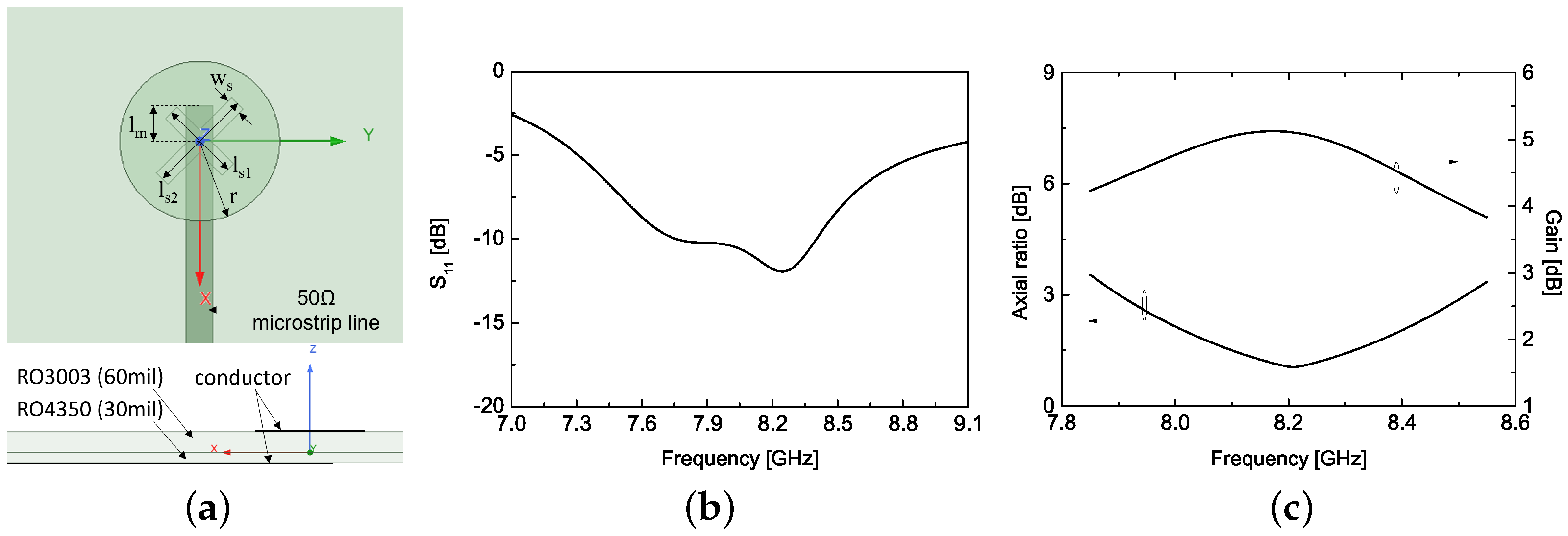


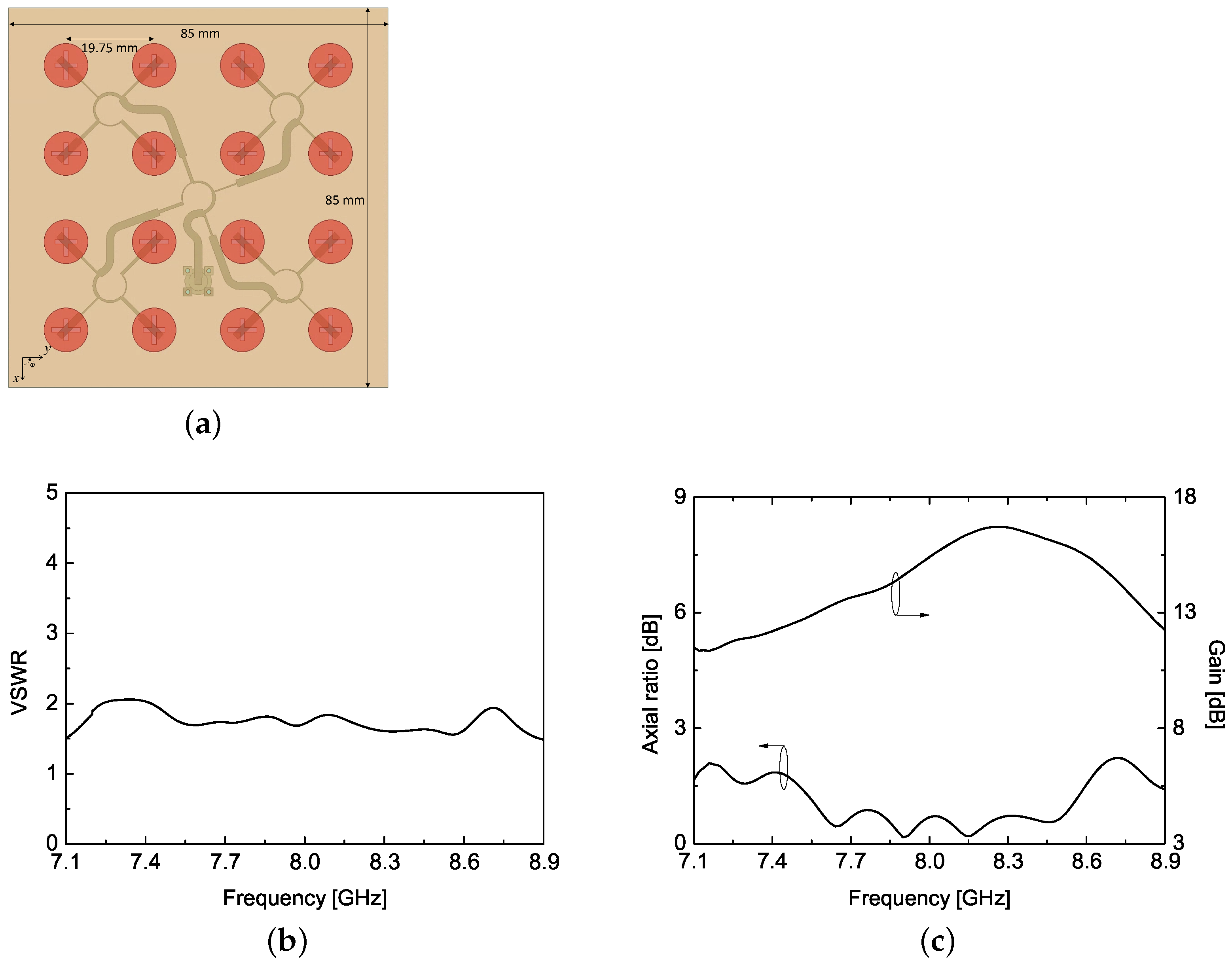

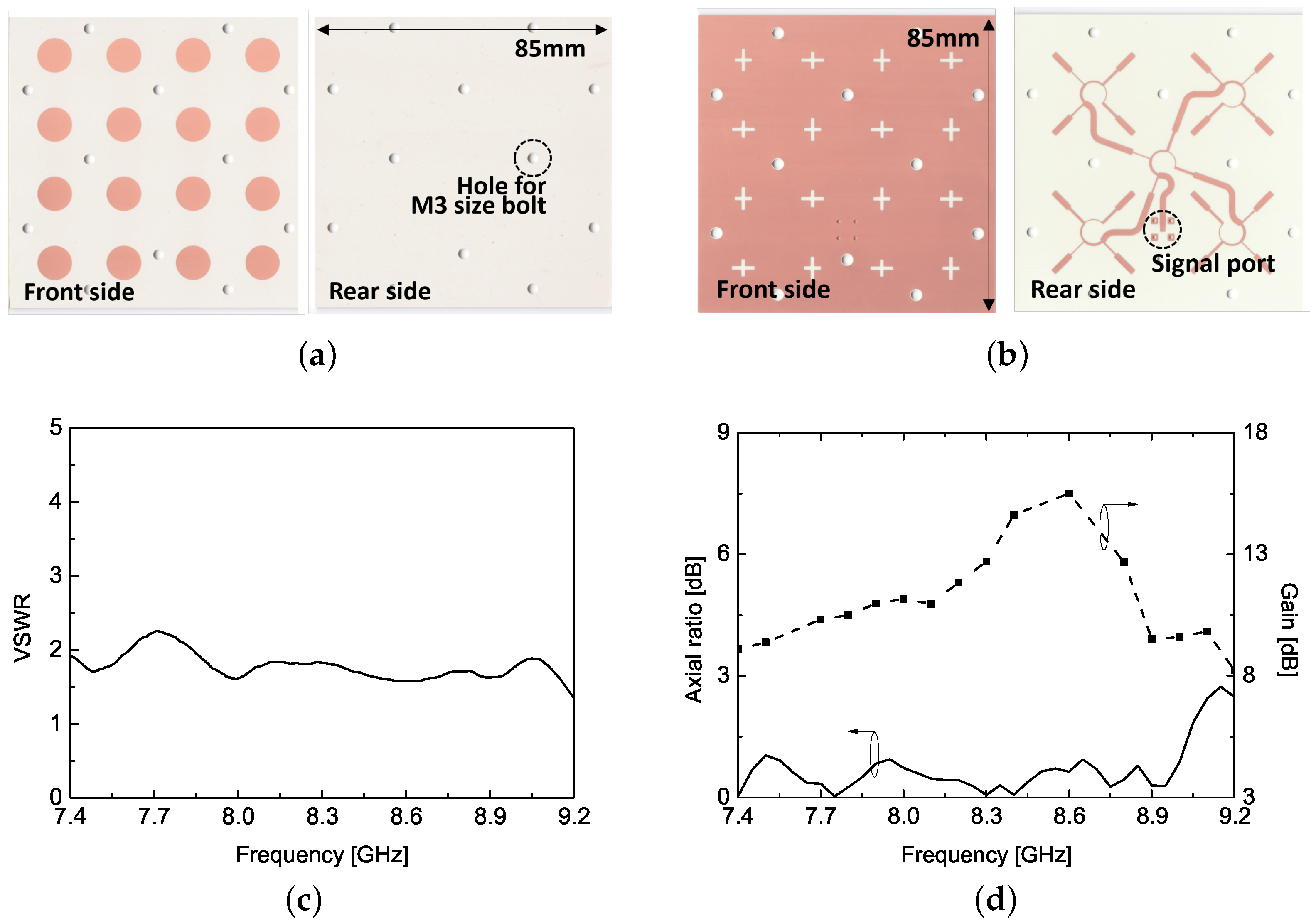
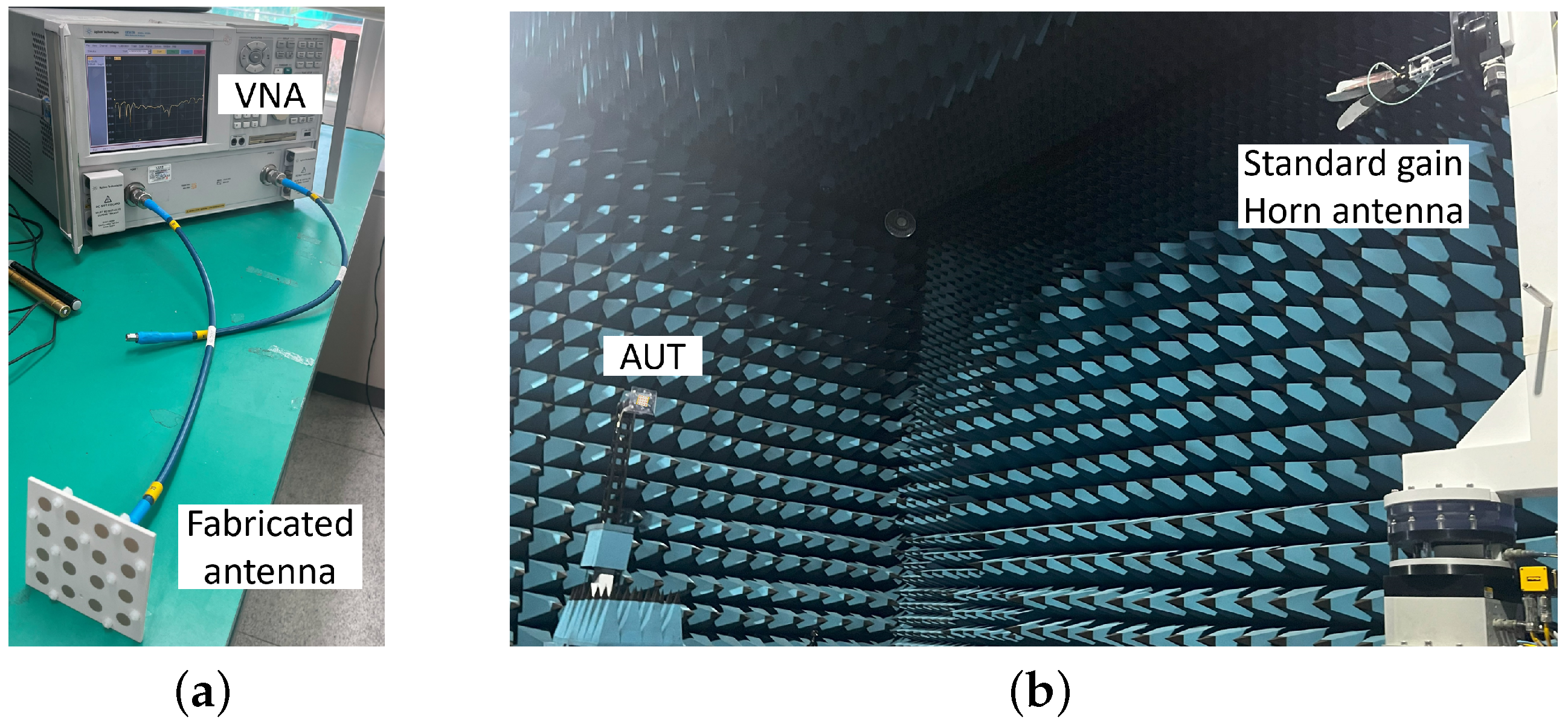
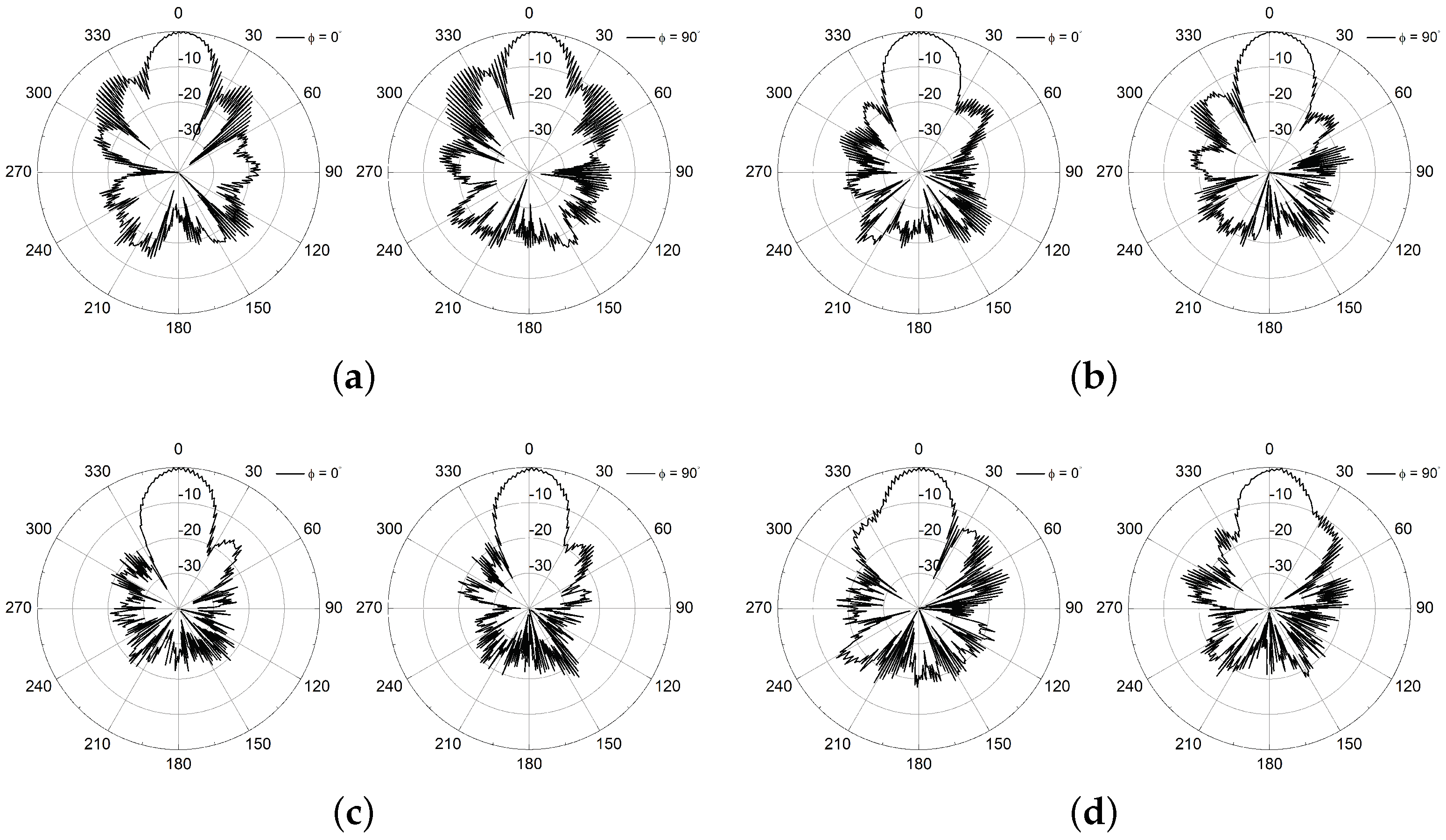
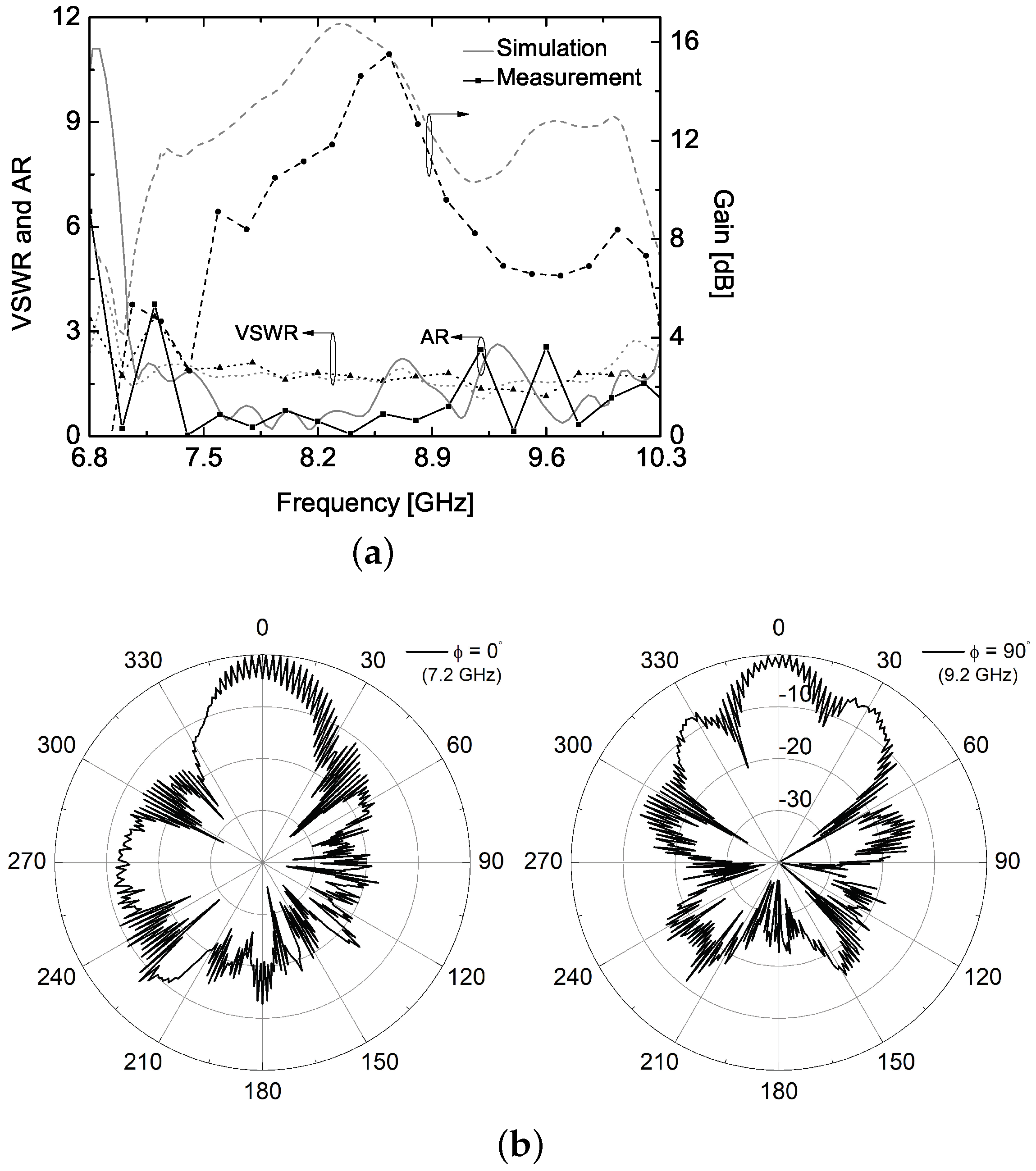
| 50 | 100 | 80 | 120 | 96 | 80 | 128 | 80 |
| Impedance BW [%] | 3dB AR BW [%] | Measured Peak Gain [dB] | Radiating Unit Type | Reflector | Size [] | |
|---|---|---|---|---|---|---|
| [11] | 55.26 | 53.5 | 2.1 | crossed dipole | X | 0.57 × 0.57 × 0.0027 |
| [13] | 132.1 | 128.6 | 9.5 | crossed dipole | O | 0.27 × 0.27 × 0.12 |
| [14] | 38.2 | 39.2 | 13.0 | crossed dipole | O | 1.61 × 1.61 × 0.25 |
| [15] | 41.2 | 56.2 | 14.2 | crossed dipole | O | 1.61 × 1.61 × 0.25 |
| [16] | 120.9 | 133.3 | 11.2 | microstrip patch | O | 0.89 × 0.89 × 0.09 |
| This work | 37.2 | 44.5 | 16.2 | microstrip patch | X | 2.32 × 2.32 × 0.062 |
Disclaimer/Publisher’s Note: The statements, opinions and data contained in all publications are solely those of the individual author(s) and contributor(s) and not of MDPI and/or the editor(s). MDPI and/or the editor(s) disclaim responsibility for any injury to people or property resulting from any ideas, methods, instructions or products referred to in the content. |
© 2024 by the authors. Licensee MDPI, Basel, Switzerland. This article is an open access article distributed under the terms and conditions of the Creative Commons Attribution (CC BY) license (https://creativecommons.org/licenses/by/4.0/).
Share and Cite
Lee, T.-H.; Jung, J.; Pyo, S. Circularly Polarized 4 × 4 Array Antenna with a Wide Axial Ratio Bandwidth. Electronics 2024, 13, 2076. https://doi.org/10.3390/electronics13112076
Lee T-H, Jung J, Pyo S. Circularly Polarized 4 × 4 Array Antenna with a Wide Axial Ratio Bandwidth. Electronics. 2024; 13(11):2076. https://doi.org/10.3390/electronics13112076
Chicago/Turabian StyleLee, Tae-Hak, Jinwoo Jung, and Seongmin Pyo. 2024. "Circularly Polarized 4 × 4 Array Antenna with a Wide Axial Ratio Bandwidth" Electronics 13, no. 11: 2076. https://doi.org/10.3390/electronics13112076






